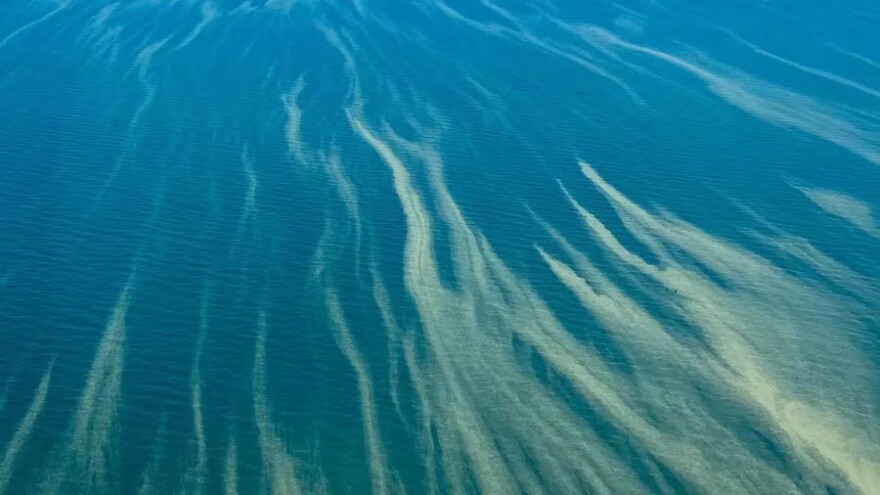Florida researchers are watching an algae bloom drifting offshore of the Tampa Bay area — and no, it’s not red tide or a looming blob of seaweed.
Scientists are monitoring a patchy cloud of “sea sawdust” that has ebbed and flowed in the Gulf of Mexico for nearly a week, according to the Florida Fish and Wildlife Research Institute. The blue-green algae species, known as Trichodesmium, is often found in tropical waters and blooms off Southwest Florida.
The good news: It’s not known to be toxic. The bad news: It leaves behind nitrogen that can feed red tide.
Sea sawdust earns its nickname from the opaque, brownish hue it reflects as it gathers on the sea surface, according to Kate Hubbard, the director of the state’s Center for Red Tide Research. From above, thick blooms can resemble oil slicks.
“It really stands out,” Hubbard said in an interview. “When you’re on the water, it pops out as something that looks different than really any other type of algae.”

Hubbard’s team tests the water for Trichodesmium regularly, and biologists verified a bloom along the Pinellas coast last Wednesday and again on Friday. They found it on Redington Beach and Sunset Beach, according to the research institute. Now, the team is waiting for a clear sky this week to capture more aerial imagery and assess its location and size, Hubbard said.
Over the past week, water samples also detected the presence of sea sawdust in Manatee and Collier counties, according to the research institute. Hubbard said it’s likely offshore of every county from Pinellas to Collier.
Most of the algae species studied throughout the Gulf of Mexico are stymied by the limited amount of nitrogen in the water that the organisms need to feed. But Trichodesmium is special: It pulls most of its nitrogen from the atmosphere. In a process called nitrogen-fixation, Trichodesmium sucks nitrogen gas from the air and turns it into ammonia, an easy-to-access fuel for marine algae species.
That means the red tide-causing organism Karenia brevis can use the nitrogen created by sea sawdust to grow and spread. It helps the toxic algae blooms in other ways, too: Red tide is sensitive under too much sunlight, but sea sawdust can also provide it with a haven of shade, according to Bob Weisberg, a physical oceanographer with the University of South Florida.
“Not only does it help to feed red tide — it helps to shade it,” Weisberg said.
There are plenty of algae species in the middle of the gulf that are depleted of nitrogen, and Trichodesmium plays an important role in their survival, Weisberg said.
“It’s able to convert nitrogen into something that other plants are able to utilize,” Weisberg said. “It’s a very important (species) on this earth.”

Red tide has waned offshore of Southwest Florida over the past several weeks, so for now, Trichodesmium doesn’t pose much of a threat. As of Tuesday afternoon, state researchers had not detected red tide bloom concentrations over the past week of water samples throughout the entire gulf region. The Karenia Brevis organism was detected in 30 samples at trace levels.
Sea sawdust tends to flare up between May and September when dust from the Sahara Desert crosses the Atlantic Ocean and brings iron with it. Trichodesmium uses the iron in the nitrogen fixation process, according to the research institute. Some strains can produce toxins, but so far there is no research to suggest harmful effects on wildlife or people in Florida.
The blooms can turn green as they start to decay, pink when pigments leak from their cells or white as pigments fade away.
“It’s just like any other phenomena on this coast: It’s patchy and it moves around,” Hubbard said.

This story was produced in partnership with the Florida Climate Reporting Network, a multi-newsroom initiative formed to cover the impacts of climate change in the state.

